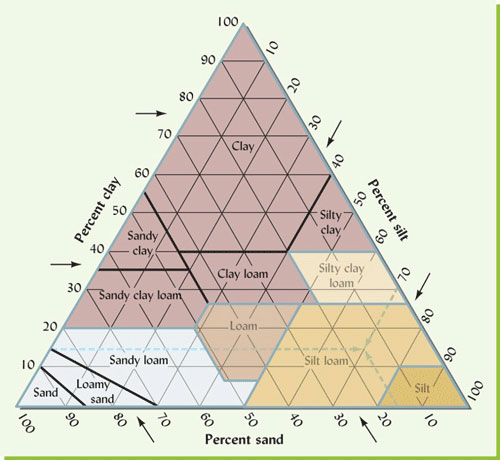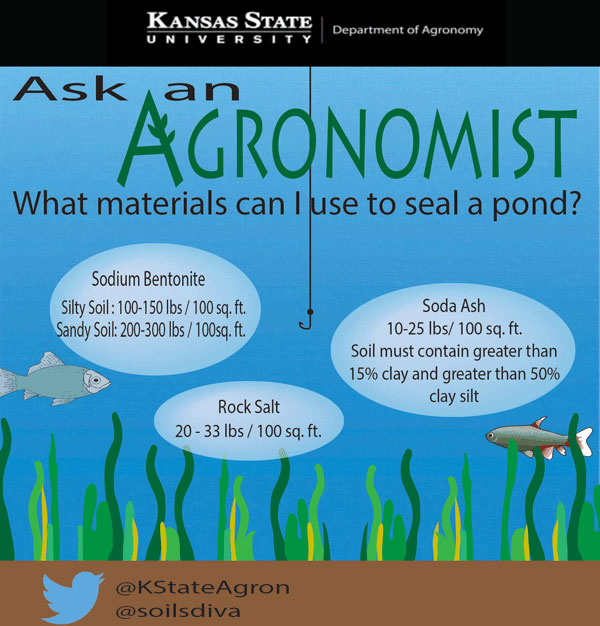Rural landowners often get a good look at the bottom of their ponds during winter and particularly after a drought, and so they might be considering corrective actions such as cleaning the sediment out or adding sealants to leaky ponds. DeAnn Presley, K-State Soil Management specialist, and Herschel George, K-State Watershed specialist, answers some frequently asked questions regarding dry ponds and what to consider before deciding to clean or amend a pond.
Q: What is the pond’s value (how much are you willing to spend) for the intended purpose?
A: Ponds are expensive. The cost to build and the future cost to rebuild the pond when necessary should always be considered. The risks of livestock loss in the mud or falling through the ice are often forgotten until the loss occurs. Not all ponds hold water well in spite of corrective measures. The most proactive thing a producer can do is place a waterer for the livestock to drink and a fence to exclude the cattle from direct access to the pond edges. Ponds require considerable maintenance. Unless you have a reliable cost estimate from a local business person, a good estimate to clean the pond is $10 per cubic yard.
Q: Should I clean my pond or make a new pond somewhere else?
A: Normally the “best” pond site was taken by the initial pond. However, if a suitable site is available, it is usually less expensive to construct a new pond than to clean sediment from an existing one. Thus, a new pond should be fully considered before deciding to clean one. Be sure to include fencing around the pond and providing a remote watering site in the cost.
Q: What is the purpose(s) of the pond?
A: Many ponds were originally built for as a water source for livestock and that may have been the best option at the time. But, is a pond the best option for the purpose now? Connection to a pressurized system either from a public water supply or a farm well can be an economic choice. Piping water to a pasture should be a financial decision. A solar pump from a pond or well might be less than half the cost of a new or cleaned-out pond and would have better quality water. See KSU Extension Pub: S-147 Waterers and Watering Systems: A Handbook for Livestock Producers and Landowners.
Q: What do you do with sediment once the pond is cleaned?
A: Often this sludge from a pond cleanout has the consistency of pancake batter - it just keeps sliding down hill. It may require a period of time to de-water before the material can be used. Placing the sediment on the back side of the dam is the best and recommended place. This sediment could be used to fill some low spots, small gullies, or ruts on the property. Putting it right next to or upslope from the pond is not a good spot because it could wash right back in.
Q: Can the removed sediment be used as a building or topsoil material?
A: Pond fill (sediment) will not have any soil structure, so it will have very little strength. It is probably not a good idea to use pond fill under a supporting wall of a building, but it might have some value for amending a degraded soil.
Q: Why is my pond dry?
A: Not all ponds are built on sites with good soil texture (% sand/silt/clay). The clay content is important for a pond to seal. Starting the pond construction with a core trench is essential. The core trench is constructed by digging a trench the length of the dam. The trench is dug down through the top soil, rock, sand or all material until a good clay soil layer is reached. Most core trenches are at least 4 feet. Clay soil is then packed back into the trench. The lack of a core trench is one of the major reasons ponds leak. Often a pond is built near a rock layer. If rock is encountered during construction, all rock layers must be padded with 6 inches or more of a high clay content material.
Q: How can you tell if a soil has enough clay?
A: Perform a ribbon test.
Ribbon test – Squeeze a moistened ball of soil into a ribbon between thumb and fingers.
- Ribbons less than 1 inch,
- Feels gritty = coarse texture (sandy) soil
- Not gritty feeling = medium texture soil, high in silt
- Ribbons 1 to 2 inches
- Feels gritty = medium texture soil
- Not gritty feeling = fine texture soil
- Ribbons greater than 2 inches = fine texture (clayey) soil
- Good for pond construction
Note: A soil with as little as 20% clay will behave as a clayey soil. A soil needs 45% to over 60% medium to coarse sand to behave as a sandy soil. In a soil with 20% clay and 80% sand, the soil will behave as a clayey soil.

Figure 1. Soil textural triangle. Graphic from The Nature and Properties of Soil, 15e, Weil and Brady.
You can also perform a moisture-by-feel test: Roll out a small clump of soil into a wire. The ideal soil moisture condition would be for it to roll out to 1/8 inch diameter without breaking or crumbling (Figure 2). If it breaks, rewet it. If it still does not roll out to 1/8 inch diameter, may not contain enough clay, and therefore, might need a soil additive.

Figure 2. Relationship between soil water content and susceptibility to compaction. Immage Source: AF115 Soil Compaction: Problems and Solutions (ksu.edu)
Q: Can you add materials to help seal a pond?
A: Dispersants such as soda ash or rock salt are used for sealing lagoons or ponds. Dispersants work by causing clay particles to swell and repel each other, thus destroying soil structure. All dispersants are to be incorporated and compacted in six-inch layers during the construction. It should be noted that adding the dispersants to an existing pond may not work. It will likely be necessary to drain the pond, clean out the sediment, scarify the bottom of the pond, add the sealant, and then compact the pond.
Soda Ash
Application rate: 10-25 lbs/100 sq. ft.
Notes: Makes a good seal. Soil must contain >15% clay, and >50% clay + silt
Rock Salt
Application rate: 20 to 33 lbs/100 sq. ft.
Notes: Least expensive. (One reference suggested rates as high as 400 lbs per 100 sq. ft. during new construction would not harm fish or inhibit vegetation).
Q: What about adding bentonite to help create a seal?
A: Bentonite is a special type of clay that swells when water is added to it so it can also be used to line a pond. However, using bentonite is an expensive option. When bentonite dries out, it will crack, and so it is not recommended for use in a pond where the water level fluctuates greatly. If bentonite is used, it should be added during the construction process and be mixed and compacted with the rest of the soil being used to construct the pond.
Bentonite
Application rate: 100-150 lbs/100 sq. ft. (silty soil)
200-300 lbs/100 sq. ft. (sandier soil)
Notes: Most expensive option

Q: How can I test the level of soil compaction for a pond?
A: Use a soil penetrometer. Cone penetrometers are often used to locate compaction. The penetrometer rod should be driven in the soil at a rate of approximately 1 inch per second.
- Level at which root growth is impossible: 300 psi
- Level at which lagoons and ponds should be compacted: 625 psi for lagoons and 725 psi for ponds.
For more information on ponds, see the USDA-NRCS publication: “Ponds – Planning, Design, Construction” at: https://www.nrcs.usda.gov/Internet/FSE_DOCUMENTS/nrcs144p2_030362.pdf
DeAnn Presley, Soil Management Specialist
deann@ksu.edu
Herschel George, Watershed Specialist
hgeorge@ksu.edu